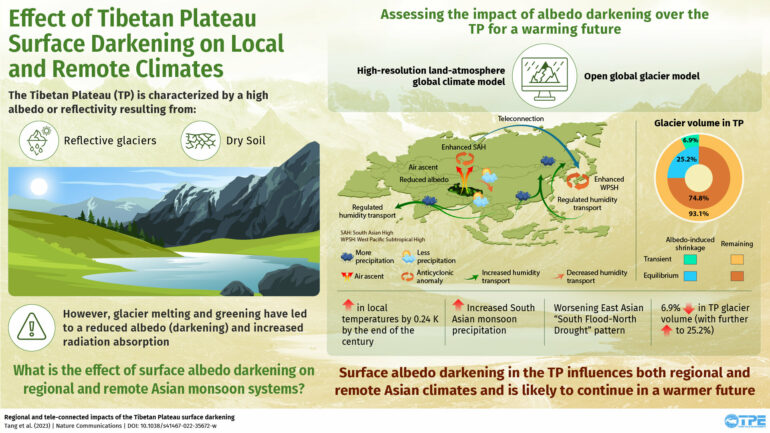Owing to global warming effects, the Tibetan Plateau (TP) region has experienced drastic changes in its land surface, characterized by melting glaciers, loss of snow cover, and vegetation greening. These, in turn, have led to a darkening of the land surface, characterized by a lower surface albedo and higher absorption of shortwave radiation.
This has resulted in increased surface temperatures, contributing to the surface darkening. However, the climatic and glaciological effects of such darkening over the TP have not been assessed or quantified.
Against this backdrop, an international team of researchers, led by Prof. Shilong Piao from the Institute of Tibetan Plateau Research at the Chinese Academy of Sciences and the new Third Pole Environment (TPE) leader, set out to investigate how surface darkening over the TP would impact regional as well as remote climates in Asia.
Their study was published in Nature Communications.
“Given that the darkening trend of the TP is likely to continue in a warmer future, it is critical to close the knowledge gap on how it will influence the climate and glacier volume in the TP as well as in other remote regions,” explains Prof. Piao.
The team adopted a high-resolution land-atmosphere global climate model (LMDZOR) and an open global glacier model (OGGM) to study the impact of TP surface darkening under a high-emission scenario. With this setup, they conducted two “experiments” to track the changes. The first was a control experiment with the present albedo values, while the second was a scenario experiment with future albedo values over the TP.
Furthermore, they used LMDZOR-simulated near-surface precipitation and air temperatures to drive the OGGM for predicting the albedo-induced glacier melting by the end of the century.
The predictions implied a significant impact of the surface darkening on the surrounding climate. The team’s projections estimated a local temperature increase of 0.24 K by the end of the century. This rise in temperature would, in turn, strengthen the TP’s thermodynamic forcing, causing hindrance to wind and humidity transport over South Asia but simultaneously propelling moist air from the Bay of Bengal to the Indian subcontinent.
This, in turn, implied an increase in the monsoon precipitation over South Asian especially Indian subcontinent. Additionally, the local and remote impacts of the surface darkening also included an intensification of the “South Flood-North Drought” pattern in East Asia.
Furthermore, the team noted a 6.9% projected loss in glacier volume (with an estimated increase to 25.2%) along with a significant loss in the western TP region. “These findings underscore the critical impacts of TP surface darkening on the climate and hydrological balances in both local and remote Asian monsoon regions,” remarks Prof. Piao.
“With this improved quantitative understanding, our study can help inform policies to reduce the risk of extreme weather events, improve water allocation strategies, and support sustainable development in affected areas. This includes policies for both ecosystem and the human use of freshwater as well as long-term climate policies,” he concludes.
More information:
Shuchang Tang et al, Regional and tele-connected impacts of the Tibetan Plateau surface darkening, Nature Communications (2023). DOI: 10.1038/s41467-022-35672-w
Provided by
Chinese Academy of Sciences
Citation:
Third pole darkening affects local and remote climates, finds study (2023, March 28)



